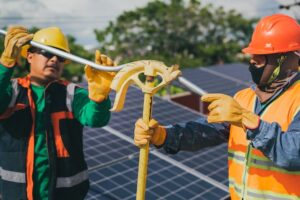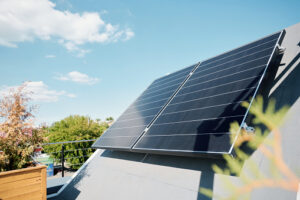When it comes to maintaining your solar panels, you're likely navigating a minefield of do's and don'ts. You might wonder if pressure washing your solar panels is a shortcut to cleanliness or a fast track to damage. It's crucial to weigh the manufacturer's recommendations against the potential risks and benefits. While pressure washing might seem like a quick fix, there are precautions you need to consider to avoid costly mistakes. Before you decide to blast away the grime, let's explore some safer alternatives and discuss how often your solar panels really need that TLC.
Key Takeaways
- Pressure washing can efficiently remove dirt from solar panels, enhancing their efficiency.
- It's crucial to follow manufacturer recommendations to avoid damaging the panels and voiding warranties.
- Alternatives like soft cloth cleaning and eco-friendly solutions are safer and recommended for solar panel maintenance.
- High-pressure washing poses risks, including panel cracking and water intrusion, necessitating careful consideration and appropriate equipment.
Understanding Pressure Washing
Pressure washing, a method employing high-pressure water spray, efficiently removes dirt, grime, and other deposits from surfaces, including solar panels. This technique's effectiveness lies in its ability to break up and wash away stubborn substances that traditional cleaning methods can't tackle. Among the pressure washing benefits, the most notable is its power to maintain or even enhance solar panel efficiency by ensuring maximum sunlight exposure.
When considering equipment types, you're looking at a range of machines, from electric to gas-powered, each with varying pressure outputs measured in pounds per square inch (PSI). It's crucial to select a machine that's robust enough to cleanse effectively, yet gentle enough to avoid damage. Typically, a washer with adjustable PSI settings offers the flexibility needed to cater to different cleaning requirements. Additionally, specific nozzles and attachments designed for delicate surfaces can further safeguard your panels during the cleaning process.
Understanding the technical nuances of pressure washing ensures you're equipped with the knowledge to select the appropriate equipment and techniques. This, in turn, guarantees the longevity and efficiency of your solar panels without compromising their integrity.
Manufacturer Recommendations
Before embarking on the cleaning process, it's essential you consult the manufacturer's guidelines for your solar panels to determine the recommended pressure settings and cleaning techniques. Manufacturer recommendations are crucial for a number of reasons:
- Warranty Implications: Using incorrect pressure settings can void your warranty. Manufacturers specify acceptable cleaning methods and pressures to ensure their products aren't damaged during maintenance. Adhering to these guidelines protects your investment and keeps the warranty intact.
- Material Compatibility: Solar panels are made from various materials, each with its own tolerance to pressure and cleaning agents. Manufacturer guidelines help you avoid using methods that could degrade these materials over time.
- Optimal Cleaning Efficiency: The recommendations take into account the design and installation angles of the panels, suggesting the most effective cleaning techniques for removing dirt and debris without causing damage.
- Environmental Factors: Manufacturers often consider local environmental factors, such as prevalent types of dirt or pollen, in their cleaning recommendations. Following these suggestions ensures that you're addressing these specific challenges effectively, without overburdening the panels.
Ignoring these guidelines could not only lead to ineffective cleaning but also risk damaging your panels or voiding your warranty. Always prioritize the manufacturer's advice to maintain the longevity and efficiency of your solar panel system.
Risks and Precautions
When cleaning solar panels, it's critical you're aware of the potential risks and necessary precautions to prevent damage to your system. Pressure washing can be highly effective, but without the right approach, you could end up compromising the integrity of your solar panels. Understanding the risks and implementing safeguards is paramount to maintaining the longevity and efficiency of your solar energy system.
| Risk Factor | Potential Damage | Precautionary Measure |
|---|---|---|
| High Pressure | Cracking or dislodging of panels | Use a low-pressure nozzle |
| Direct Water Jet | Water intrusion, leading to short circuits | Spray at an angle, never directly |
| Weather Impact | Thermal shock from cold water on hot panels | Clean during mild, overcast conditions |
| Chemical Usage | Corrosion or discoloration | Use only solar panel-approved chemicals |
Be particularly cautious of the weather impact; sudden temperature changes can cause materials to contract or expand, leading to micro-cracks. Moreover, the chemical usage should be strictly monitored. Avoid harsh detergents that can degrade the protective coatings on your panels. By adhering to these guidelines, you'll ensure your solar panels remain efficient and damage-free for years to come.
Alternatives to Pressure Washing
If you're looking for a safer alternative to pressure washing your solar panels, several methods can effectively clean without risking damage. These methods are not only less harsh but also apply eco-friendly principles, ensuring that you're taking care of your investment and the environment simultaneously. Manual scrubbing plays a pivotal role in these alternatives, offering precise control over the cleaning process. Here's a breakdown of some effective methods:
- Soft Cloth and Soapy Water: Utilize a soft, non-abrasive cloth coupled with eco-friendly soapy water. This method is gentle on the panels and can remove most surface dirt and grime effectively.
- Telescopic Brush: For areas that are hard to reach, a telescopic brush can offer the reach and control needed to clean safely from the ground.
- Eco-Friendly Cleaning Solutions: Opt for biodegradable and eco-friendly cleaning solutions specifically designed for solar panels. These solutions break down dirt without harming the panel's surface.
- Scheduled Manual Scrubbing: Incorporating regular, gentle manual scrubbing into your maintenance routine can prevent the accumulation of stubborn dirt, making it easier to maintain the panels' efficiency without the need for harsh cleaning methods.
Maintenance and Cleaning Frequency
Having explored the safer alternatives to pressure washing your solar panels, it's crucial to understand the recommended maintenance and cleaning frequency to ensure optimal performance. The frequency of cleaning depends on several factors, including your location, the panel's exposure to dust and debris, and seasonal weather patterns. Using the right cleaning solutions is essential to avoid damaging the panels' surfaces.
Here's a brief guide to help you plan your solar panel maintenance schedule:
| Frequency | Recommendations |
|---|---|
| Monthly | Visual inspection for debris or damage. No cleaning with solutions required unless located in very dusty areas. |
| Quarterly | Light cleaning with a soft brush and specialized solar panel cleaning solutions to remove superficial dirt. |
| Bi-annually | Thorough cleaning recommended, especially after the pollen season and before winter. Consider professional cleaning services if accessible. |
| Annually | Professional inspection and cleaning. Ideal time for a detailed check of the mounting hardware and electrical systems. |
Seasonal timing plays a significant role in planning your maintenance schedule. For instance, scheduling a thorough cleaning session post-pollen season and before the onset of winter can help maintain the efficiency of your solar panels throughout the year. Remember, using gentle, manufacturer-approved cleaning solutions during each cleaning session will protect your investment and ensure the longevity of your solar panels.
Conclusion
In conclusion, while pressure washing your solar panels might seem like a quick fix, it's crucial to heed manufacturer guidelines to avoid damage. The risks associated with high-pressure water can lead to costly repairs. Instead, explore safer alternatives like soft brushes or specialized cleaning solutions. Regular maintenance, aligned with the specific recommendations of your solar system's manufacturer, ensures optimal performance and longevity. Always prioritize precision and care in your cleaning approach to safeguard your solar investment.



